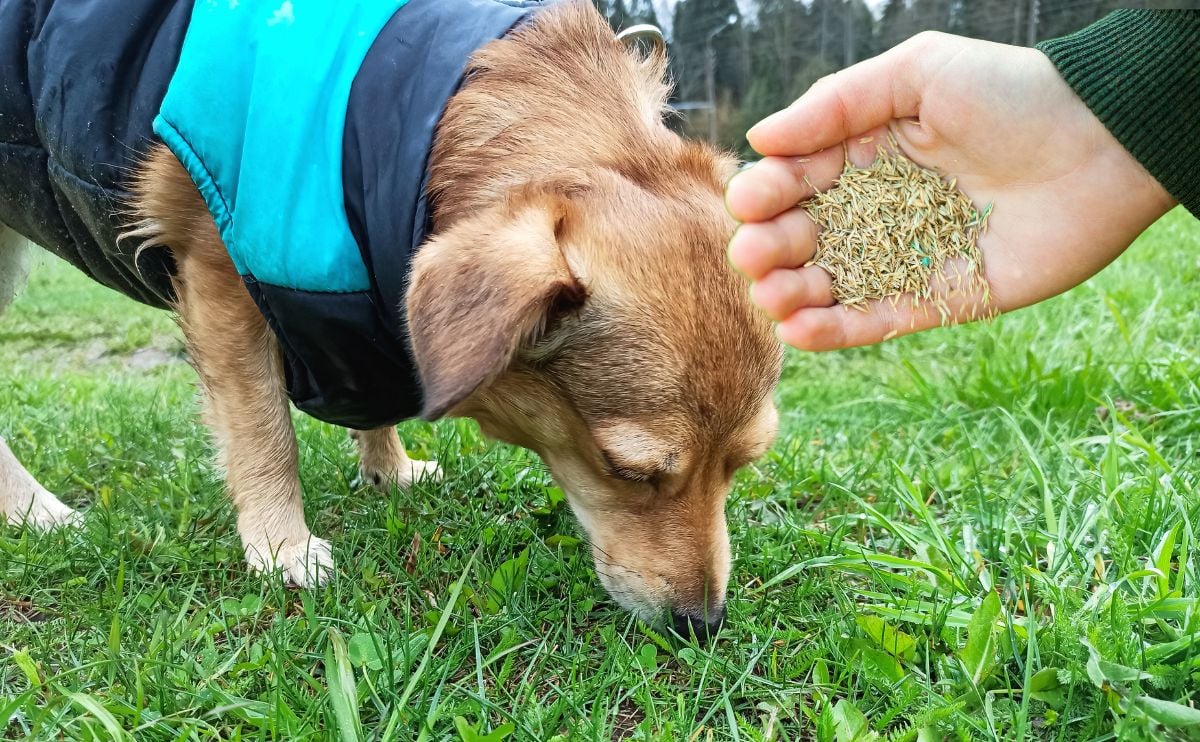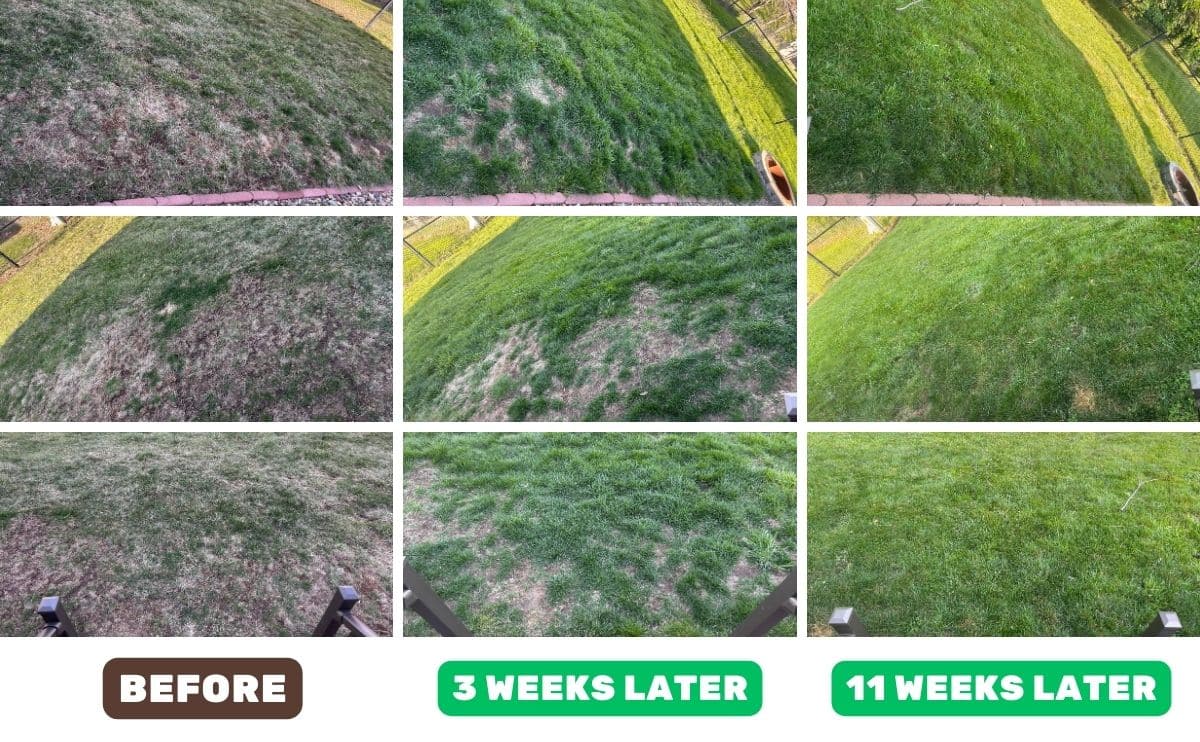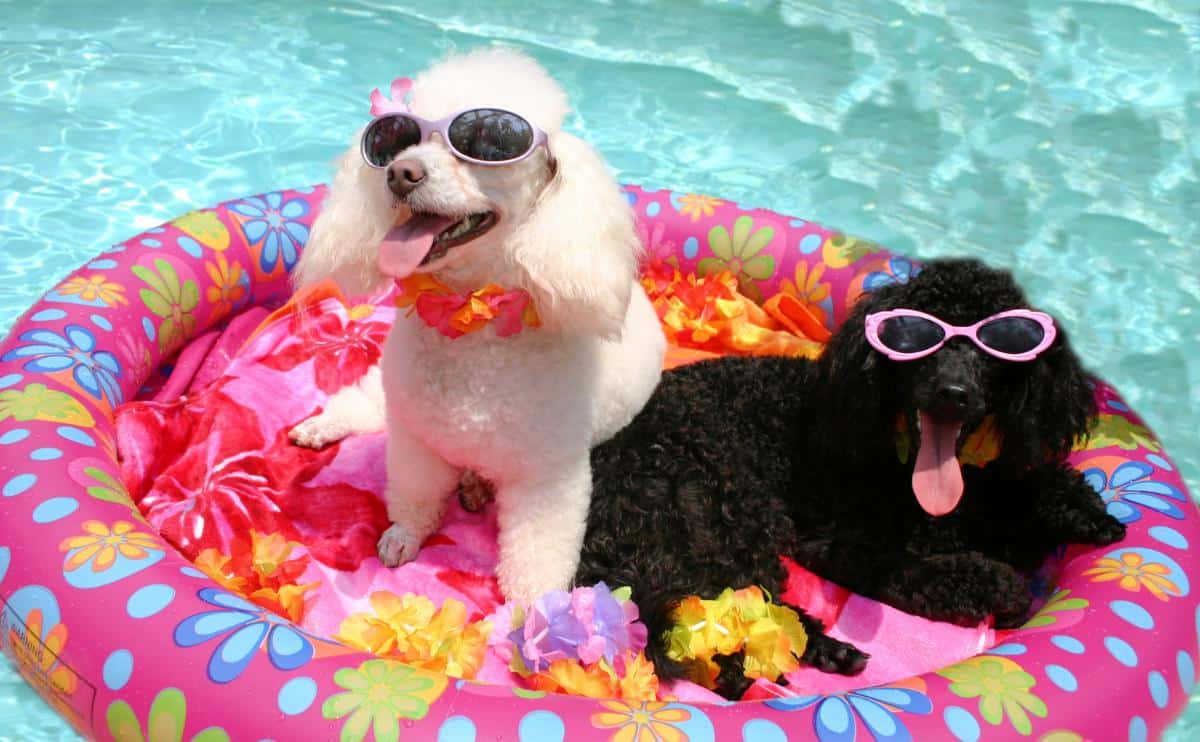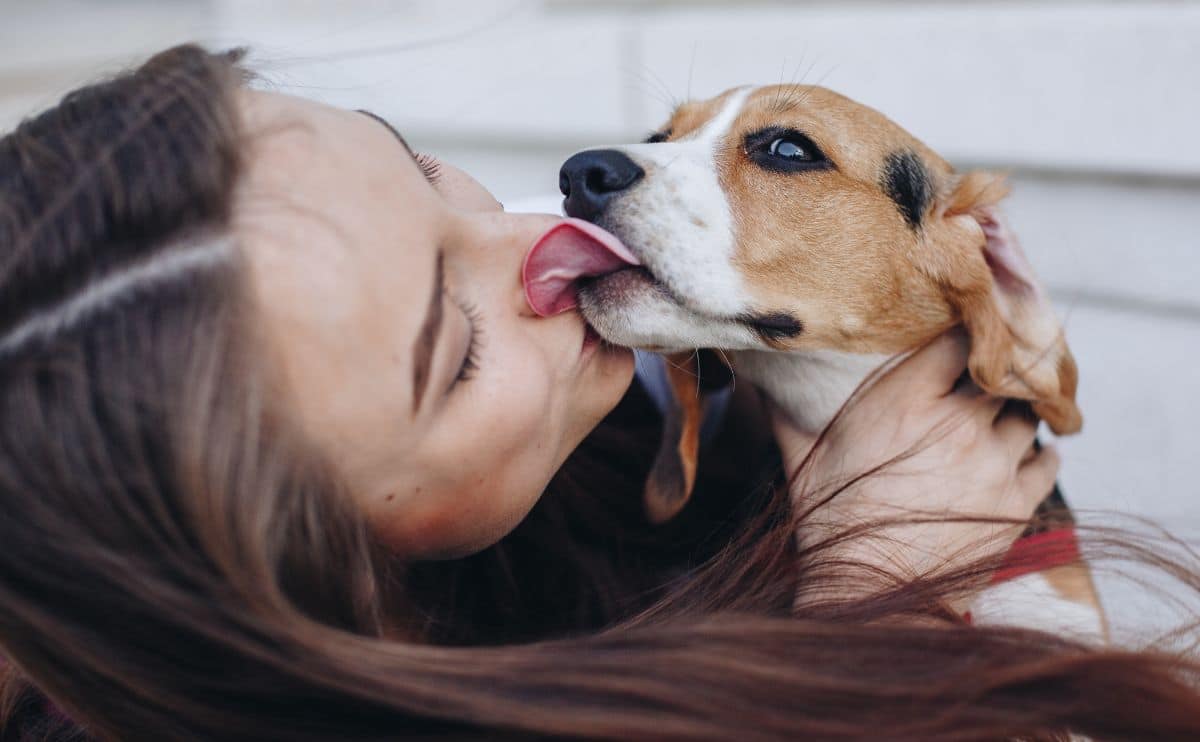Best Grass Seed For Dogs: Pet-Friendly & Urine-Resistant
When you purchase through links on our site, we may earn a commission. Here’s how it works.

Dogs have done some serious damage to my lawn. In the past, my lawn has been covered in dog urine spots from my dog and my neighbors’ dogs. Plus, dogs love to use their scent to mark their territory by scratching the grass after going potty. Seeing the grass fling up in my yard used to make me cringe. But now, I’ve found the best grass seed for dogs that is urine-resistant.
Table of Contents
What Region Do You Live In?
Different grasses thrive in various conditions. Some do well in shade, while others require full sun, and some do well in drought, while others require lots of water. These growth requirements subsequently result in some grasses doing better in the northern region of the United States and others being a better fit in the southern region. Knowing your region will help narrow down which grass type is best for your lawn.

Find where you live on the map above to determine if you’re in the northern or southern region. If you live along the separator line on the north side, you’ll want grass seed that performs well in northern transitional climates. Oppositely, if you live along the separator line on the south side, you’ll want southern, transitional grass seeds.
3 Grass Growth Habits: Rhizomatous, Stoloniferous & Bunching
One technical item I’d like to briefly go over before you choose the best grass type for your lawn is the different growth habits. Grass grows in three different ways: rhizomatous, stoloniferous, and bunching.

- Bunching grasses form clumps of grass that grow upward from the crown. Bunchgrasses are often less dense than rhizomatous and stoloniferous grasses because they require reseeding for patchy areas and overseeding for general thickening up.
- Rhizomatous grasses are spread by rhizomes, which are small, horizontal stems slightly beneath the soil’s surface. As rhizomes develop, they grow new roots downward and shoot stems upward. A new tuft of grass grows where the rhizome ends, and the process repeats, helping spread the grass and make it denser.
- Stoloniferous grasses are spread by stolons, which are tiny, horizontal stems that creep along the soil’s surface. As stolons develop, they establish new tufts of grass and send down roots. The process repeats, helping the grass spread and thicken up.
Grasses that grow from bunching are typically the easiest to eliminate. Simply removing the crown and roots will keep the grass from returning. On the other hand, grasses that spread from rhizomes or stolons are trickier to eliminate because you need to remove or kill the crown, roots, rhizomes, and stolons to prevent them from returning. However, for the sake of our topic (best grass seed for dogs), grasses that spread from rhizomes and stolons are usually preferred among pet owners because they can heal dog-related dead patches on their own.
Tall Fescue vs Kentucky Bluegrass vs Perennial Ryegrass vs Bermudagrass vs Centipedegrass vs Zoysiagrass

I’ve selected three of the most popular dog-friendly grass seed types for the northern and southern regions and put together a comparison table to help you see the key features. Remember to consider your area before narrowing your choices down.
| Tall Fescue | Kentucky Bluegrass | Perennial Ryegrass | Bermudagrass | Centipedegrass | Zoysiagrass | |
|---|---|---|---|---|---|---|
| Region | Northern | Northern | Northern | Southern | Southern | Southern |
| Growth Habit | Bunch | Rhizomes | Bunch | Stolons & Rhizomes | Stolons | Stolons & Rhizomes |
| Shade Tolerance | Moderate | Low | Low | Low | Moderate | Moderate |
| Heat Tolerance | High | Low | Low | High | High | High |
| Drought Tolerance | Moderate – High | Moderate | Low | High | Moderate | Moderate |
| Foot Traffic Tolerance | Moderate | Moderate | High | High | Low | High |
| Mowing Frequency | Frequent | Moderate | Moderate | Frequent | Infrequent | Moderate |
| Ideal Height | 2-4″ | 2-3″ | 2-3″ | 1-2.5″ | 1.5-2″ | 1-2.5″ |
Tall Fescue
Tall fescue grass, scientifically known as Schedonorus arundinaceus (previously Festuca arundinacea), has deep roots, which help make it resilient to people and pets playing and running. However, if it does get damaged, it doesn’t heal itself, so you’ll have to reseed patchy areas. To maintain its density, you’ll want to overseed your lawn in the fall about 1-2 months before your average frost date.
Kentucky Bluegrass
Poa pratensis, more commonly known as Kentucky bluegrass, is stunningly blue-green. Its soft texture makes it an excellent choice for laying in or rolling around in. Once established, Kentucky bluegrass proliferates. If areas become damaged by your dog, Kentucky bluegrass can heal itself quickly thanks to its rhizomes.
Perennial Ryegrass
Perennial Ryegrass (Lolium perenne) may be your solution if you struggle with patchy areas from your dog’s urine. Perennial Ryegrass is a dog urine-resistant grass seed and does exceptionally well in coastal areas. It is less resistant to the extreme cold than Kentucky Bluegrass is, so this is something to keep in mind if you’re farther north. Perennial Ryegrass doesn’t heal itself and will require reseeding. Because it’s fast-growing, it’s also a good choice for reseeding dead spots in your lawn.
Bermudagrass
Bermudagrass, or Cynodon dactylon, has a deep-rooted system that spreads rapidly. It can heal from pet damage quickly and is resistant to many diseases. Bermudagrass is typically the grass type used on golf courses as it can withstand high foot traffic. However, it requires more maintenance, requiring frequent mowing, watering, and fertilizing to maintain its health. Bermudagrass is salt-tolerant, so it’s excellent for lawns with pets due to the salt in their urine, something that other grass types struggle with.
Centipedegrass
Eremochloa ophiuroides, or centipedegrass, can be finicky with its soil drainage and pH requirements (it prefers more acidic soil), and establishing it can be some work. However, once stable, it’s resilient and requires very little maintenance. This grass needs lots of water, which can help dilute dog urine and prevent those pesky yellow patches in your lawn. Centipedegrass grows slowly, meaning less mowing, and it’s very soft, so dogs love rolling around in it.
Zoysiagrass
Zoysiagrass, scientifically known as Zoysia japonica (also referred to as Korean lawngrass or Japanese lawngrass), is a slow burn, taking 2-4 years to fully establish. However, once established, it grows thick and plush, having a carpet-like appearance. Unfortunately, it recovers slowly when it is damaged.
How To Grow Grass Seed
Grass seed is typically planted in spring or fall when temperatures are cooler than in summer. Planting at the right time for your location impacts the germination and success of your efforts.
Bags of grass seed usually have directions for when to plant the seed, what the temperature should be, and how often to water it. I used Sunday’s Fescue Rescue grass seed blend to repair a large patch in my lawn from some utility work that was done. The back of the bag included easy step-by-step instructions. See the process and my Sunday pet lawn grass seed results in the short one-minute video below.
Germination Rate & Temperature Requirements For Tall Fescue, Kentucky Bluegrass, Perennial Ryegrass, Bermudagrass, Centipedegrass & Zoysiagrass
Below are the average germination rates and temperature requirements for the different grasses to show you when you could plant grass seed in your area and how long it may take to start seeing growth.
| Tall Fescue | Kentucky Bluegrass | Perennial Ryegrass | Bermudagrass | Centipedegrass | Zoysiagrass | |
|---|---|---|---|---|---|---|
| Germination Rate | 5-15 Days | 7-30 Days | 5-10 Days | 10-30 Days | 14-21 Days | 10-21 Days |
| Air Temperature | 65-85°F | 60-80°F | 60-80°F | 70-90°F | 70-90°F | 70-90°F |
| Soil Temperature | 60-75°F | 55-70°F | 55-70°F | 65-80°F | 70°F+ | 65-70°F |
Sunday Lawn Care Grass Seed Options
I’m a big fan of Sunday’s lawn care products and pest solutions and have seen excellent results with many of their products. Below are Sunday’s grass seed options, but first, look at Sunday’s Seed Map to see which grasses work in your region.
Compare your grass options below and pick the one best for you based on its features and the purpose for which you plan to use it.
| Sunday Grass Seed | Region | Grass Types | Key Features | Sun Requirements | Use |
|---|---|---|---|---|---|
| Pet Lawn (5lb bag) | Northern, Transitional | Tall Fescue, Perennial Ryegrass | Pet-Resistant Seed Blend | Full Sun To Light Shade | Overseed, New Lawn |
| Pet Lawn Bare Repair (3.75lb jug) | Northern, Transitional | Tall Fescue, Perennial Ryegrass | Urine-Resistant Grass Types | Full Sun To Light Shade | Patch Repair |
| Fescue Rescue (5lb bag) | Northern, Transitional | 3 Fescue Varieties | Easy Care, Drought-Tolerant, Fast Growing, Dark Green | Full Sun To Partial Shade | Overseed, New Lawn, Patch Repair |
| Lucky Lawn (5lb bag) | Northern, Transitional | Tall Fescue, Fine Fescue, Clover | Pollinator-Friendly, Easy Care | Full Sun To Partial Shade | Overseed, New Lawn, Patch Repair |
| Shade Select (5lb bag) | Northern, Transitional | Fine Fescue | Low-Maintenance, Dense Growth | Low Sun | Overseed, New Lawn, Patch Repair |
| Kentucky’s Best (5lb bag) | Northern | Kentucky Bluegrass, Ryegrass | Famously Soft & Thick, Emerald Green | Full Sun To Partial Shade | Overseed, New Lawn, Patch Repair |
| Bermuda Time (5lb bag) | Southern | Bermudagrass | Heat & Drought-Tolerant, Grayish Green | Full Sun | Overseed, New Lawn |
| Bare Repair Bermudagrass (3.75lb jug) | Southern | Bermudagrass | Easy To Use, Grayish Green | Full Sun | Patch Repair |
Sunday’s Seed Finder Quiz
Unsure which grass to choose? Sunday’s Seed Finder Quiz takes the guesswork away and tells you which products are best for your lawn. I used it for my lawn, and here’s how easy it was.
First, I entered my address, and Sunday told me what region I was in and what yard size I had.
Next, I click on the main issue I’m currently facing with my lawn. My lawn struggles with bare patches from my dog’s urine spots.

My dog goes outside to sunbathe and go potty. She’s not keen on fetch or playing, so I selected “not much” for how often she’s on the lawn. I decided against the clover as I love the look of grass-only lawns. However, clover benefits pollinators, so it’s good for the environment. I try my best to help pollinators in other ways by planting lots of native plants and having a bee house, birdhouses, and bird feeders accessible.

The final question is about how much shade the yard gets. My lawn gets a lot of sun, especially the front yard, so I need grass that thrives in the sun. Then, the suggested product is shared in the results based on your answers and your yard’s specific needs.

Sunday recommended their Fescue Rescue grass seed blend, which includes three fescue varieties. It works in my northern region and does best in full sun and light shade areas. It’s a perfect match for my grass needs, and it was easy to grow and maintain all summer. It is also pet-safe grass seed, as all of Sunday’s products are pet-friendly.
The Best Way To Repair Pet Urine Spots In Grass
One of the biggest lawn frustrations with pets is dog urine killing grass. Although growing grass seed is an option, it would take more work than we preferred because you need to keep all traffic off the area and water consistently to grow grass seed. My dog loves to go to the same spots in the yard to do her business, and I didn’t want to take her out on a leash whenever she wanted to go outside.
Sunday’s Pet Patch is a game-changer for those pesky dog urine spots on my lawn. It’s my absolute favorite product from Sunday. It completely turned all those brownish-yellow pet urine spots into lush, bright green grass. The before-and-after photos are so satisfying to see. Plus, it’s easy to use and safe for pets to walk on, unlike growing grass from scratch.

4 Tips For Growing Grass Seed
Sunday gave me a bunch of tips to help make my grass-growing venture successful. I want to share them with you so you have as easy an experience as I did.
- Fall is the prime time for seeding! The temps are right for germination, weeds are less competitive, and you’ll replace any grass that died off from summer stress.
- Pre-emergents (aka “weed & feed”) prevent seed germination! If you’ve recently applied one, wait to seed.
- Clover was commonly grown with grass to boost lawn resilience until the 1950s, when herbicide companies began demonizing it to increase sales. Clover feeds pollinators, fixes nitrogen, and doesn’t require a lot of sun or water. Bonus—it can grow where other grass struggles.
- Grow resilient turf by mowing high to encourage more profound root growth—especially for shaded grass, which is more vulnerable to foot traffic and heat stress.
Sunday Can Help With Your Lawn Care & Pest Control Needs
Sunday’s entire product lineup is pet-friendly. In 2021, I started using Sunday’s smart lawn plan because I wanted to avoid harsh chemicals and use something that’s earth-friendly and pet-safe. I notice significant differences between my lawn and my neighbors’ lawns each summer. Mine is always much more vibrant, green, and healthy-looking. Meanwhile, theirs has more brown, and they use professional lawn care services with harsh chemicals that are bad for the planet, pets, and people. My Sunday Lawn Care Review has all the details, including my experience and before/after photos.
Sunday also offers pest control products that I started using in 2023. We had a really rainy spring, which increased the presence of mosquitos. I was so frustrated because I spend a lot of time outside with my family and enjoy gardening. The mosquitos were making outdoor time unenjoyable. Sunday’s Mosquito Deleto eliminated my issue entirely. You can read all about my experience in my comparison of the Best Pet-Safe Pest Control Options.
Why Trust Canine Journal?
Kimberly has tried many solutions to address the damage her lawn has faced from dog damage. After three years of trying countless products, Kimberly discovered the perfect solution, Sunday. Kimberly has years of experience using Sunday for her lawn care needs. She has noticed vast improvements to her lawn and can see noticeable differences between her lawn and her neighbors’ lawns. Kimberly has also used Sunday’s pest control and some of their gardening items. Her in-depth research and first-hand experience make her an expert in all things related to pet-safe lawn care.





